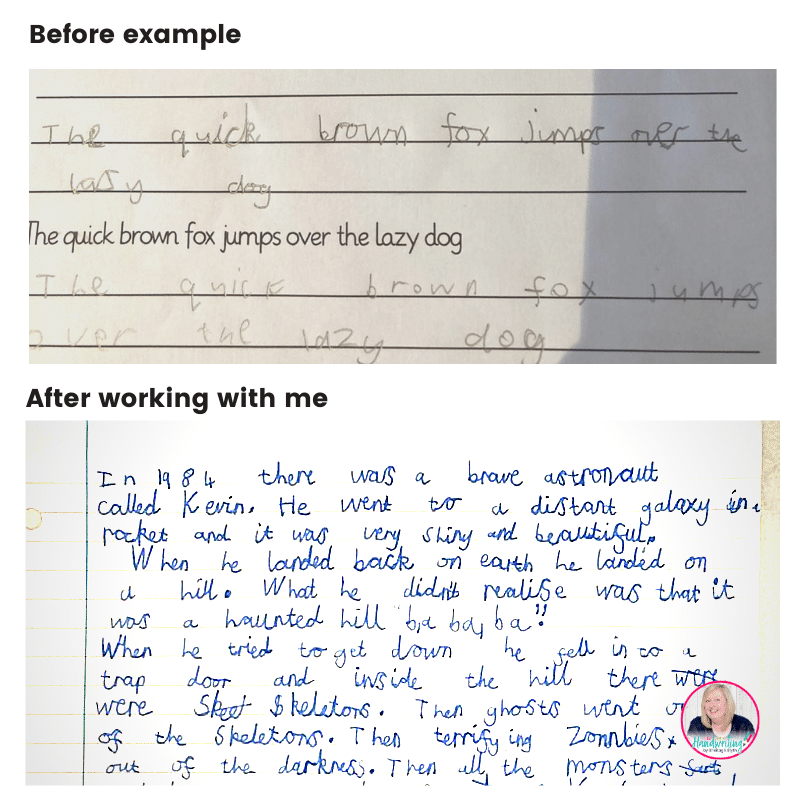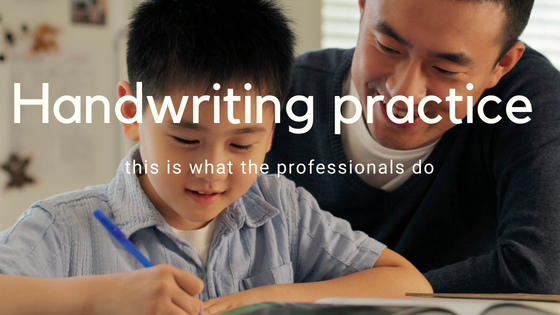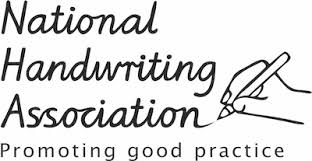Handwriting practice 6 to 7 years

Has your child’s teacher advised extra handwriting practice?
Does your child say their hand hurts when writing?
Are you concerned that the more handwriting your child does the more unhappy they become?
Want to teach your child handwriting, the sam as how a children's occupational therapist would teach it?
In this article, we will look at some quick and important handwriting strategies that you can do with your child.
Handwriting practice at this age is all about consolidating previous skills.
Your child should be able to review their own work. Noticing the good, the bad and, dare I say it, the ugly.
They should be looking at:
- Have they got a good pencil grip?
- Are their words properly spaced out?
- Can their words sit on the line?
- Are their letters formed accurately?
At your child’s school handwriting practice is usually only for 15 minutes a day. The school may also be talk of handwriting rewards or pen licenses. These are motivational tools to help children write.
The real difficulty at this age is that kids notice differences
They notice what their best friend can do. They notice what their second best friend can do. And they notice what they can’t do. This can be a very demotivating.
It is essential that we help. Online handwriting tutors.
Children need to feel confident about how they write.

Let me tell you about Charlie

Charlie had always been a hard worker. Keen to learn, keen to ask questions and keen to try. However, Charlie found handwriting difficult.
He was noticing that his friends were able to do their work with ease. Yet Charlie seemed to be the last one to finish his work. He told his Mum that his hand hurt and handwriting made him tired.
When writing Charlie would lean on the table. After a few minutes of holding a pencil he would wiggle his fingers. He did this to get the blood flowing back into his hands.
Charlie was given a sloping board by his school Senco to use at school when writing. But this didn't help him improve his writing. I advised him to do core strength muscle activities e.g. press ups and doing a superman pose. Charlie also changed his pencil grip to a pen that was ergonomically designed to help him write. We worked together learning about animal facts, predators and bugs whilst helping him to improve his letter sizing and word spacing.
All these ideas helped Charlie improve his handwriting. I am pleased to share that he is no longer the last to complete his work.
How handwriting practice at home can you improve your kids handwriting
Hand exercises
This is very important. Hand exercises relieve muscle tension. The hand continues to develop up until the age of 6 to 7 years. As a child increases the amount of handwriting they do. They can often say their hand hurts. This is due to the extra fine motor movements that they are making.
Use a highlighter to help show spaces
Colour in the gaps between the letters and the words. This will help your child see that letter spaces need to be smaller than between words. Highlighter pens can also help a child learn how to write on the line.
Maze puzzles
These are great at helping to develop ‘eye hand’ coordination skills. Furthermore it develops pencil control and accuracy. Whilst your child is completing a maze they are developing essential hand skills.
Encourage
Provide constant praise. Handwriting is a difficult skill. Time is needed to learn it. Encourage writing in your home by asking your child to write a ‘to do’ list for you. Or write little notes of encouragement and ask for notes back of what went well today.
Help your child reflect on their work
Finally this is a technique that is used at school. You could use words such as good, great, not so good. Or ask them to mark themselves out of 10. Be advised, often they will undermark their skills if marking out of 10.
Mistakes (what NOT to do when doing handwriting practice with your child)
No guidance
Your child still needs help with letter formations. Having start and stop points is not enough. They will need guide arrows to help them move their pencil to write direction.
Leaning on the table
Sometimes this is thought of as tiredness. But it can also be a sign of reduced core muscle strength. Writing on a sloping board or an inverted A4 folder will help make handwriting less tiring.
Using a pencil grip
Pencil grips do not always help with the finger position when writing. Your child needs a gap between their thumb and first finger. Otherwise round letters are difficult to draw. Some pencil grips do not encourage this gap, making them useless.
To summarise kids handwriting practice 6 to 7 years is all about:
Between the ages of six and seven years handwriting practice is about consolidating what has already been taught.
It is about being able to hold a pencil without your hand hurting. Clearly form letters in the correct direction. And place spaces between words.
Children at this age are very aware of what they can and cannot do. It is important that we do not let handwriting become a demotivating factor for them. It is best to continue to praise neat work.





